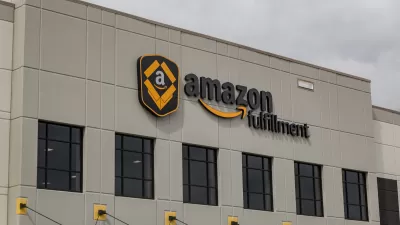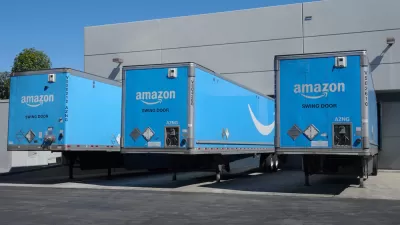With demand for sprawling e-commerce warehouses growing, New Jersey’s State Planning Commission has released a series of documents outlining best practices for cities examining warehouse proposals.

Writing on CentralJersey.com, Tom Gilbert, Co-Executive Director of New Jersey Conservation, highlights a set of guidance documents released by the State Planning Commission that informs towns about the impact of warehouse sprawl to give them important context for making decisions about warehouse proposals in their areas.
As Gilbert writes, “New Jersey is a ‘home rule’ state, so most decisions affecting land-use are made at the local level. Our state also has a history of statewide and regional planning, which is often needed to address challenges that municipalities can’t deal with on their own.”
According to the commission’s report, “With its strategic geographic position, skilled workforce, major consumer markets, and robust transportation infrastructure that serves the entire Northeast, New Jersey is an ideal location for the warehousing and goods movement industries.” Some towns are tempted by the jobs, tax revenue, and other benefits warehouses can bring. “But many other towns – often bolstered by vehement citizen opposition – are concerned that warehouse development will lead to the loss of prime farmland, truck traffic, noise, dust, air pollution and potential flooding that would irreparably harm the quality of life in their communities.”
The guidance documents “provide a detailed checklist of factors for towns to consider when developing or updating their master plans and zoning ordinances.” Some key points include:
- “Towns should update and refine their regulations to ensure that they accurately assess their ability to handle truck traffic and related impacts.”
- “Zoning should be very specific, not broad.”
- “While warehouses aren’t covered in the state’s Environmental Justice Law, municipalities should take into account the impacts of air pollution on overburdened communities.”
For Gilbert, these documents are a useful first step, but “More tools will be needed to fix this problem, such as model ordinances, multi-municipal planning, and carrots or sticks from the state to align warehouse development with the guidance.”
FULL STORY: The State We’re In: Helping New Jersey towns tackle warehouse sprawl

Planetizen Federal Action Tracker
A weekly monitor of how Trump’s orders and actions are impacting planners and planning in America.

San Francisco's School District Spent $105M To Build Affordable Housing for Teachers — And That's Just the Beginning
SFUSD joins a growing list of school districts using their land holdings to address housing affordability challenges faced by their own employees.

The Tiny, Adorable $7,000 Car Turning Japan Onto EVs
The single seat Mibot charges from a regular plug as quickly as an iPad, and is about half the price of an average EV.

Seattle's Plan for Adopting Driverless Cars
Equity, safety, accessibility and affordability are front of mind as the city prepares for robotaxis and other autonomous vehicles.

As Trump Phases Out FEMA, Is It Time to Flee the Floodplains?
With less federal funding available for disaster relief efforts, the need to relocate at-risk communities is more urgent than ever.

With Protected Lanes, 460% More People Commute by Bike
For those needing more ammo, more data proving what we already knew is here.
Urban Design for Planners 1: Software Tools
This six-course series explores essential urban design concepts using open source software and equips planners with the tools they need to participate fully in the urban design process.
Planning for Universal Design
Learn the tools for implementing Universal Design in planning regulations.
Smith Gee Studio
City of Charlotte
City of Camden Redevelopment Agency
City of Astoria
Transportation Research & Education Center (TREC) at Portland State University
US High Speed Rail Association
City of Camden Redevelopment Agency
Municipality of Princeton (NJ)





























